
Bergerocactus emoryi is a species of cactus, known commonly as the golden-spined cereus, golden snake cactus, velvet cactus or golden club cactus. It is a relatively small cactus, but it can form dense thickets or colonies, with the dense yellow spines giving off a velvety appearance when backlit by the sun. From April to May, yellow, green-tinged flowers emerge, which transform into reddish, globular fruit. This species is native to the California Floristic Province, and is found in northwestern Baja California and a small part of California, in San Diego County and on the southern Channel Islands. Where the Mediterranean climate of the California Floristic Province collides with the subtropical Sonoran Desert near El Rosario, hybrids with two other species of cacti are found. It is the sole member of the monotypic genus Bergerocactus, named after German botanist Alwin Berger.

Coastal sage scrub, also known as coastal scrub, CSS, or soft chaparral, is a low scrubland plant community of the California coastal sage and chaparral subecoregion, found in coastal California and northwestern coastal Baja California. It is within the California chaparral and woodlands ecoregion, of the Mediterranean forests, woodlands, and scrub biome.
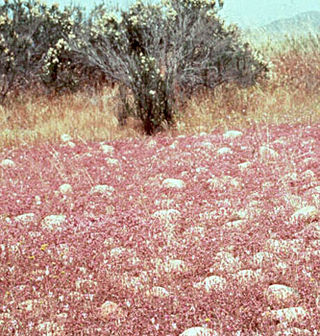
Pogogyne abramsii is a rare species of flowering plant in the mint family known by the common name San Diego mesa mint.

Ornithostaphylos is a monotypic plant genus which contains the single species Ornithostaphylos oppositifolia, commonly known as the Baja California birdbush or Baja California manzanita. A large, evergreen shrub in the heather family, this species is near-endemic to northwestern Baja California, with a small population just north of the border in San Ysidro, California. It produces a much-branched inflorescence of white, urn-shaped flowers, and has leathery leaves that appear opposite or in whorls. These characteristics separate it from its close relatives in the region, which include manzanitas (Arctostaphylos), summer holly (Comarostaphylis) and mission manzanita (Xylococcus).

Arctostaphylos glandulosa, with the common name Eastwood's manzanita, is a species of manzanita.

Eryngium aristulatum, known by the common names California eryngo and Jepson's button celery, is a species of flowering plant in the family Apiaceae.

Euphorbia misera is a semi-succulent shrub in the genus Euphorbia commonly known as the cliff spurge or coast spurge. A drought-deciduous shrub, it is typically found as a gnarled, straggly plant occupying seashore bluffs, hills and deserts. Like other members of its genus, it has a milky sap, which can be found exuding out of the light gray bark when damaged. The alternately-arranged leaves are round and folded in the middle, with small hairs on them. The "flowers" can be found blooming year-round, and are colored maroon or yellow in the center with 5 white to light-yellow petal-like appendages attached outside. This species is native to the Baja California peninsula and Sonora in Mexico, and the coast of southern California in the United States, where it is a rare species. It is threatened in some localities by the development of its coastal habitat, which tends to be prime locations for high-end residential and commercial developments.

Artemisia palmeri is a rare species of sagebrush known by the common names San Diego sagewort and Palmer sagewort.

Baccharis vanessae is a rare California species of Baccharis known by the common name Encinitas baccharis. It is native primarily to San Diego County, California, almost endemic to the county except for one population a few miles over the county line in Riverside County. It is a member of the chaparral flora. It is a federally listed threatened species. It is present in several sites in Encinitas, and it is known from other parts of the county from the coastline to the mountains on various substrates. There are perhaps 15 populations remaining, for a total of about 2000 individuals. Some of the remaining occurrences are on land which may be cleared for development.

Chaenactis glabriuscula, with the common name yellow pincushion, is a species of flowering plant in the daisy family. It is native to California and Baja California.
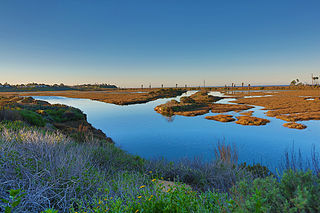
San Elijo Lagoon Ecological Reserve is one of the largest remaining coastal wetlands in San Diego County, California, United States.
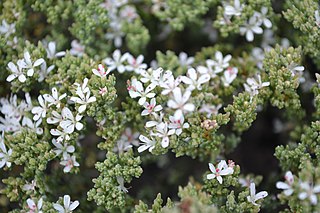
Frankenia palmeri is a species of flowering plant in the frankenia family, Frankeniaceae, known by the common name Palmer's seaheath, Palmer's frankenia, or yerba reuma. It is native to the coastline of northwestern Mexico, as well as San Diego County, California, in the United States. It is a plant of sand dunes, beaches, alkali flats, and salt marshes, where it thrives due to its adaptation to saline soils. This is a small, tangling shrub less than a meter tall with spreading stems lined with clusters of knobby, fleshy leaves. Toward the ends of branches flowers appear among the leaf clusters. Each flower has white petals 3 or 4 millimeters long, often washed with pink toward the throat and with pink anthers. The plant is becoming increasingly rare as its habitat on valuable coastal land is consumed for development.

Acmispon prostratus, synonyms Lotus nuttallianus and Syrmatium prostratum, is a species of legume native to California and northwestern Mexico. It is known by the common names beach lotus, Nuttall's lotus, and wire bird's-foot trefoil. It is native to Baja California and just into San Diego County, California, where it is a resident of coastal habitats, such as beaches and bluffs.
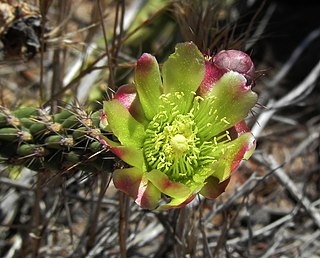
Cylindropuntia californica is a species of cholla cactus known by the common name snake cholla. It is primarily found in Baja California, Mexico and the southernmost part of California in the United States. It is characterized by a short, decumbent habit, yellow-green flowers, elongated stems, and short spines. It is mostly found in coastal sage scrub and coastal chaparral habitats, but two varieties in Baja California can be found in foothills and deserts. In California, variety californica is regarded as a rare and threatened plant, with a California Native Plant Society listing of 1B.1, in part due to its limited number of occurrences and threats from development. It formerly was considered to have a larger range due to the inclusion of Cylindropuntia bernardina within it as the variety parkeri.
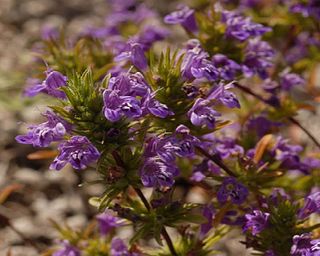
Pogogyne nudiuscula is a rare species of flowering plant in the mint family known by the common name Otay mesa mint. It is native to southern San Diego County, California, where it is known only from Otay Mesa near the border with Baja California. It was identified on land south of the Mexican border, but these occurrences have probably been extirpated. It is now known from seven vernal pool complexes just north of the border, and it is a federally listed endangered species of the United States.
Packera ganderi is a rare species of flowering plant in the aster family known by the common name Gander's ragwort. It is endemic to southern California, where it is known from a few occurrences in San Diego and Riverside Counties.
Eriogonum evanidum is a rare species of wild buckwheat known by the common name vanishing wild buckwheat. It is native to southern California and Baja California, where it has been collected from widely scattered areas. Most historical occurrences are now extirpated. Some sources suggested that it was probably extinct, but living specimens were rediscovered in 2007.

Eryngium pendletonense is a rare species of flowering plant in the carrot family known by the common name Pendleton button-celery. It is endemic to northern San Diego County, California, where it is known from four occurrences along the coastline between Oceanside and the Orange County border, including land within Camp Pendleton. It grows on vernally moist coastal grassland and coastal sage scrub habitat with clay soils. It was first described as a species in 1999.
Poa diaboli is a rare species of grass known by the common name Diablo Canyon bluegrass. It is endemic to San Luis Obispo County, California, where it is known from about five occurrences in the San Luis Mountains near the coast. The type specimen was collected in Montaña de Oro State Park and the grass was described as a new species in 2003. The grass occurs on rugged mountaintops and north-facing slopes in thin soils covering shale rock within a few kilometers of the coastline. Its habitat includes chaparral, oak woodland, coastal sage scrub, and Bishop pine forest.

Convolvulus simulans is a species of annual plant in the morning glory family known as the small-flowered morning-glory and small-flowered bindweed. It is an inconspicuous vining plant that is characterized by tiny pale pink or pale blue bell-shaped flowers. It is typically restricted to clay and serpentine substrates in annual grassland, coastal sage scrub and chaparral habitats. This species is native to Arizona, California, and Baja California. Some taxonomies place this species under Convolvulus equitans.

















